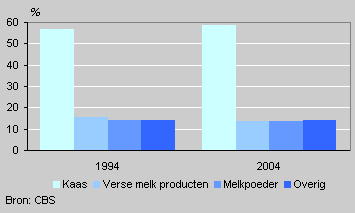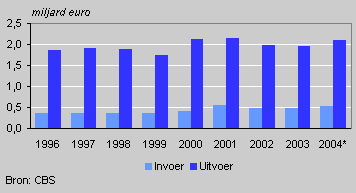More milk ends up as cheese

In 2004 59 percent of Dutch cow’s milk was processed to make cheese. This is 2 percent more than ten years ago. The Dutch dairy industry is therefore still largely dependent on cheese production, although the production of butter is decreasing.
Dairy products made from milk

10.5 billion kilograms of milk
10.5 billion kilograms of milk were supplied to Dutch dairy factories in 2004. Fifty-nine percent of this milk was used to make cheese. A smaller part (14 percent) ends up in the shops as fresh milk or a fresh milk product, and about the same amount is processed into powdered milk. The remainder of the milk is processed into other dairy products such as condensed milk, butter and cream.
670 million kilograms of factory cheese
Last year Dutch dairy factories produced 670 million kilograms of factory cheese. Just as in 2003 the production of factory cheese was just over 2 percent higher than in the previous year, thus continuing the recovery in cheese production since the dip in 2001 and 2002.
Less butter and powdered milk
Dairy factories are making less and less butter. In 2004 they produced 100 million kilograms, less than the previous year for the third year in succession. Compared with 2003 they made 13 percent less.
The production of powdered milk was one tenth lower in 2004 than the year before, returning to the level of 2002. The Dutch dairy industry produced an average 170 million kilograms of powdered milk in the seven preceding years, with a peak in 2003. In 2004 dairy factories produced 160 million kilograms. In spite the high production in recent years, the Netherlands is still a net importer of powdered milk.
Cheese trade

Cheese exports
The value of cheese exports has fluctuated around 2 billion euro in the last five years. Cheese imports rose considerably in this period. Five years ago 353 million euro worth of cheese was imported. In 2004 this had risen to 514 million euro, an increase of more than 40 percent.
Folkert van der Werf